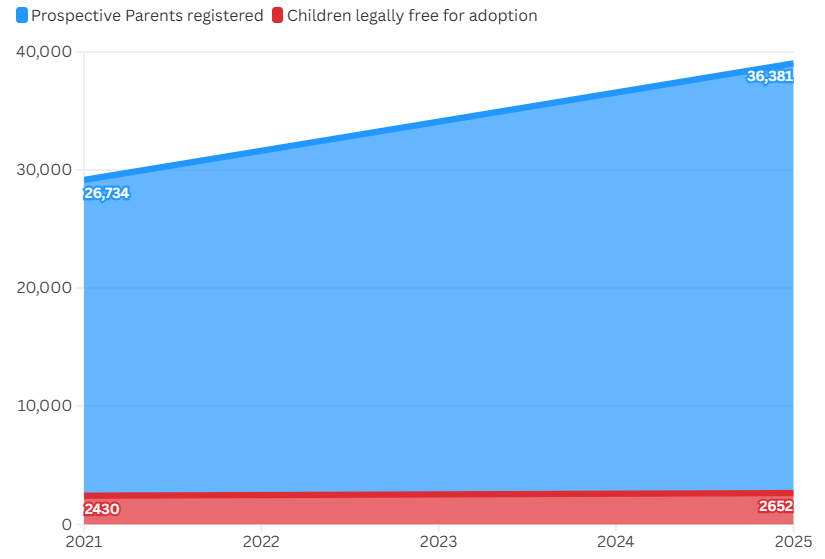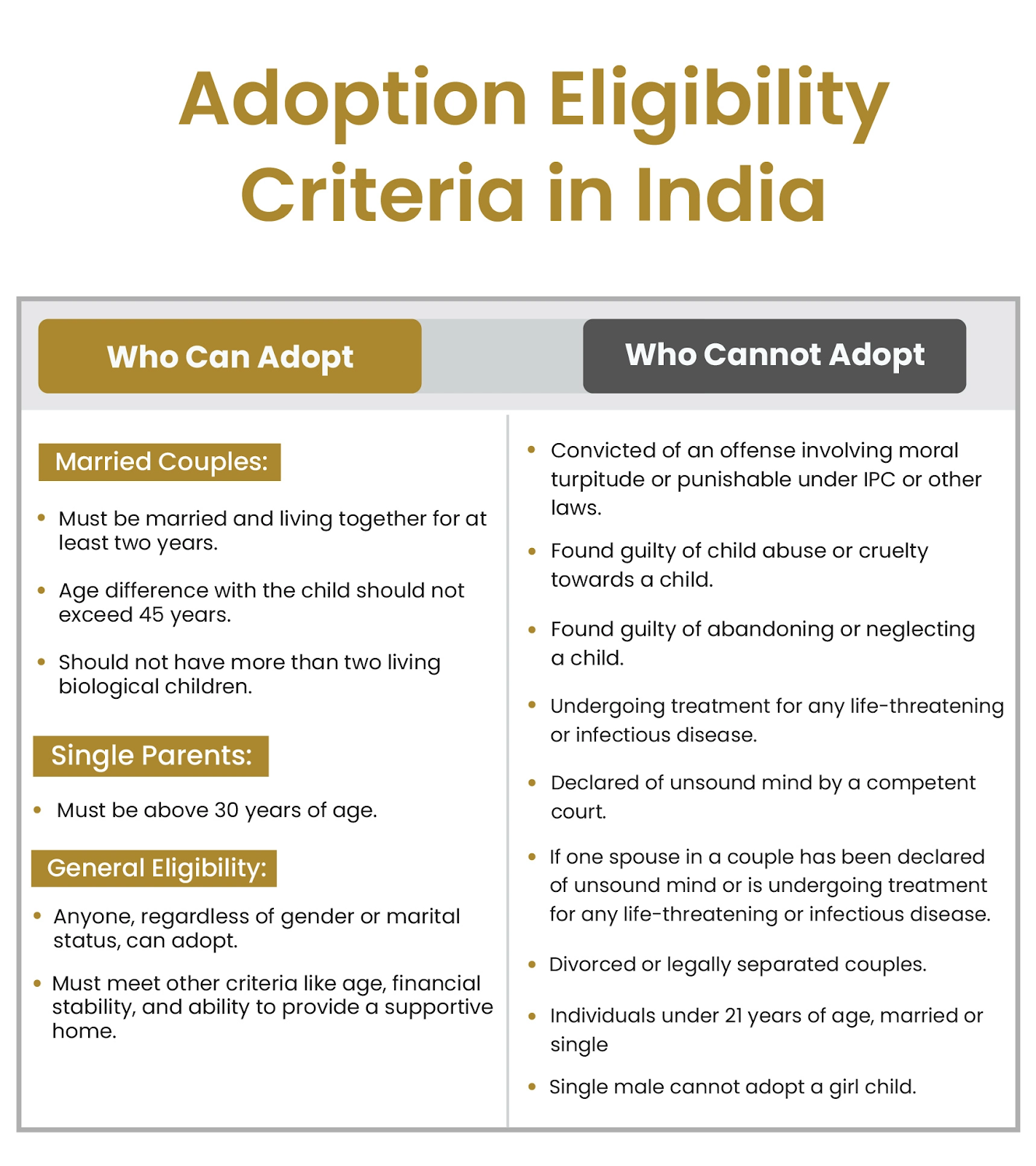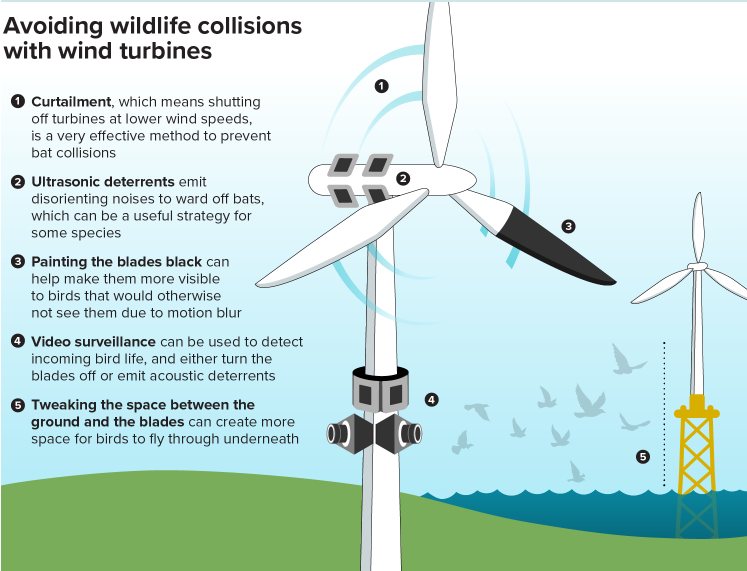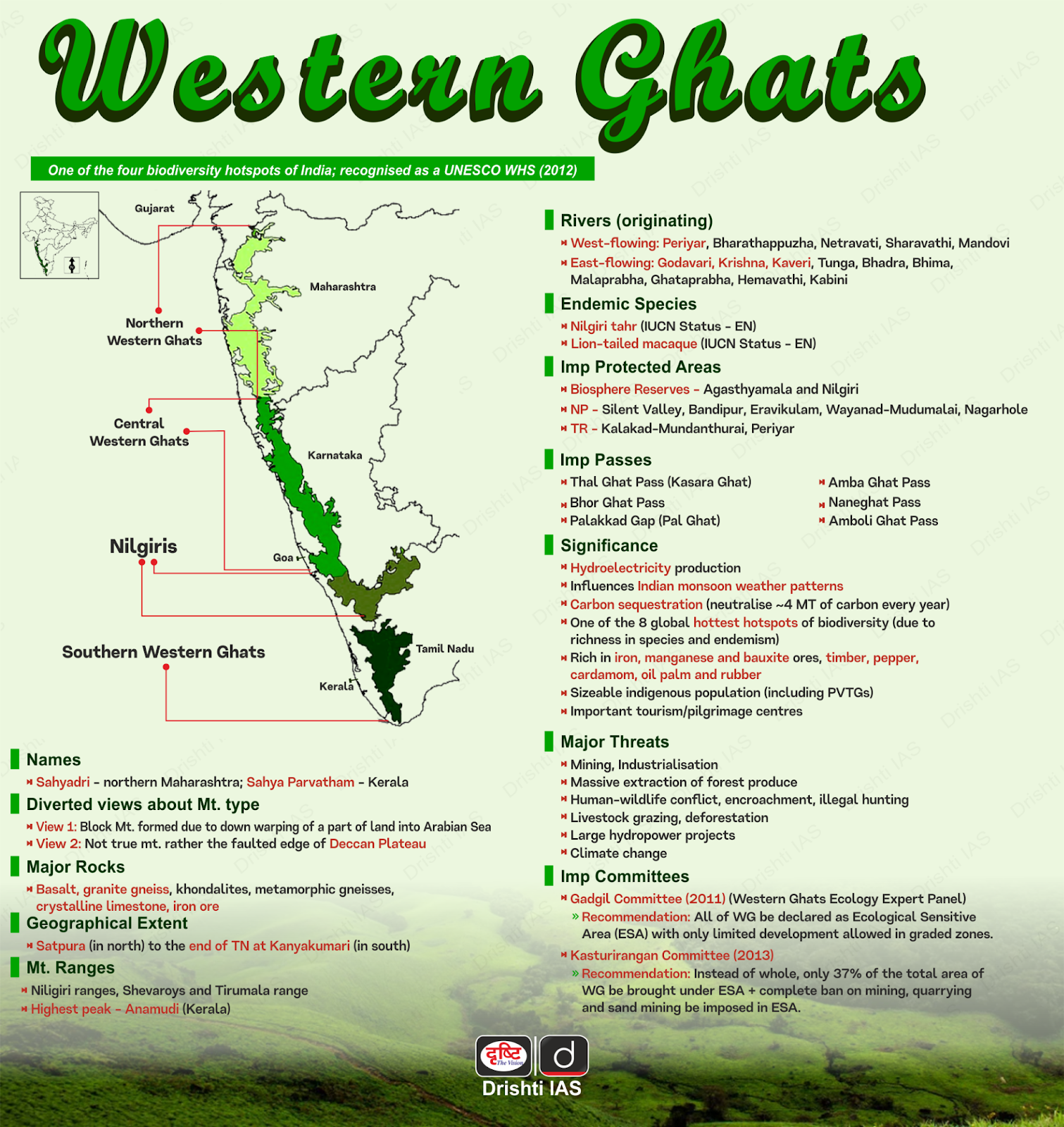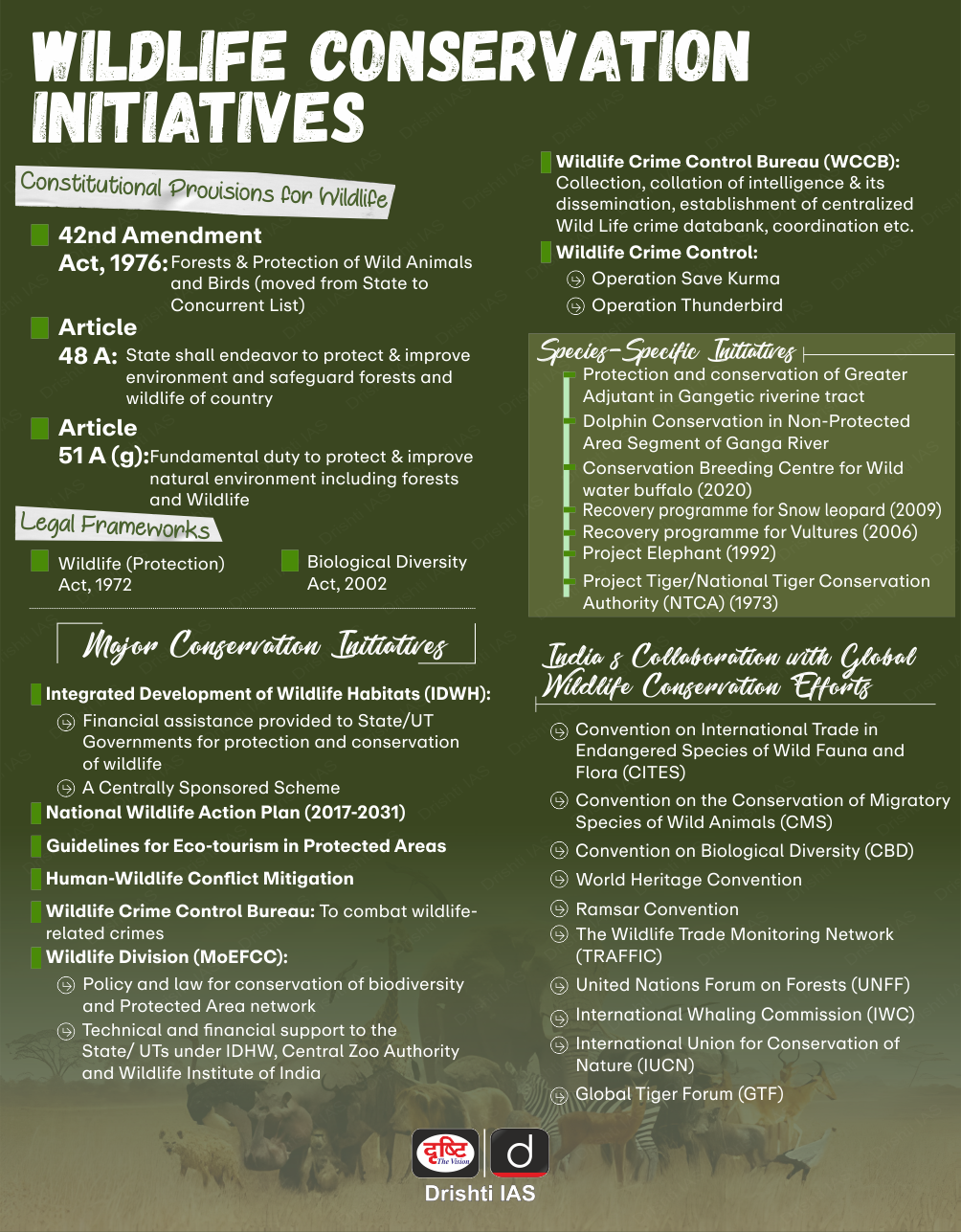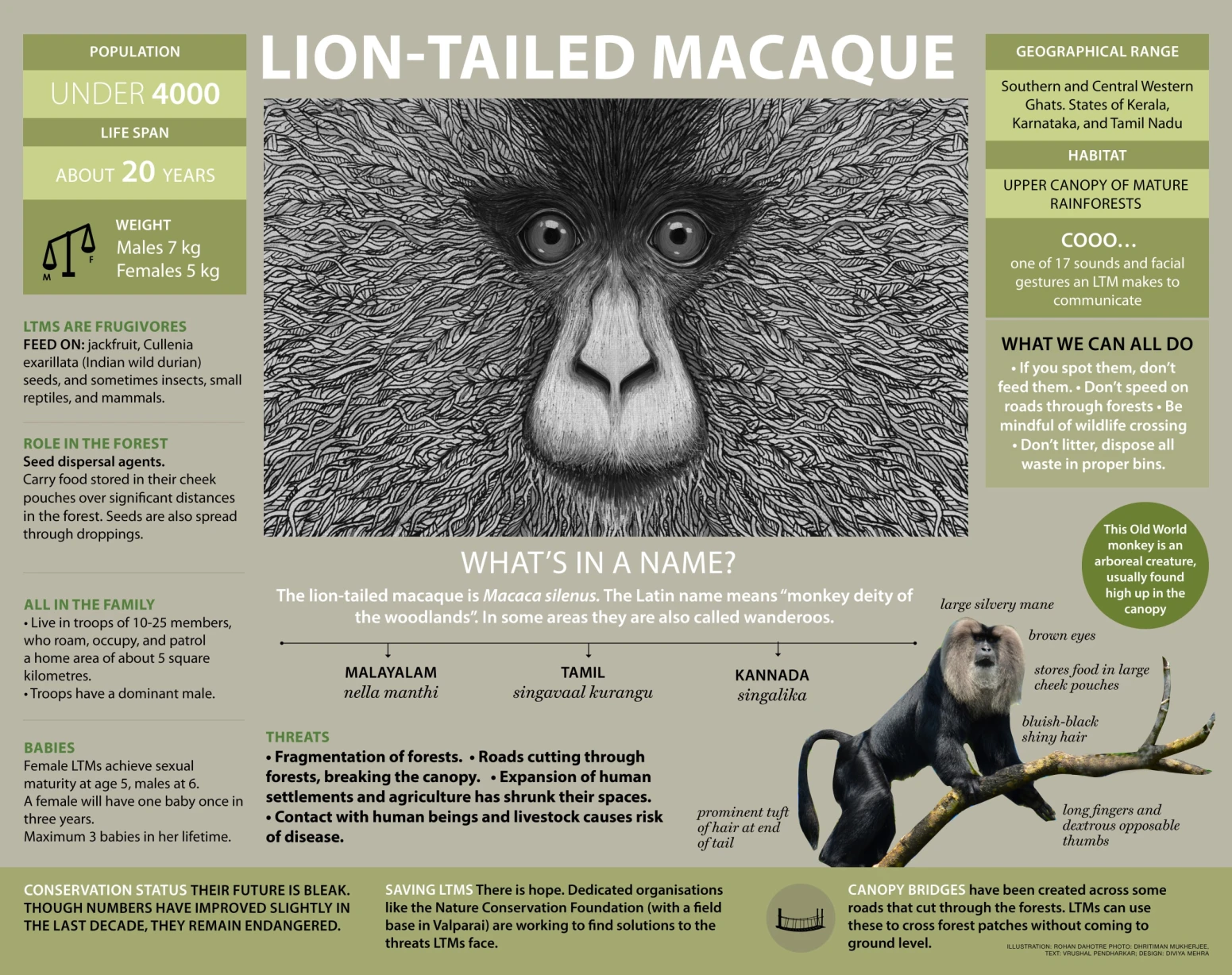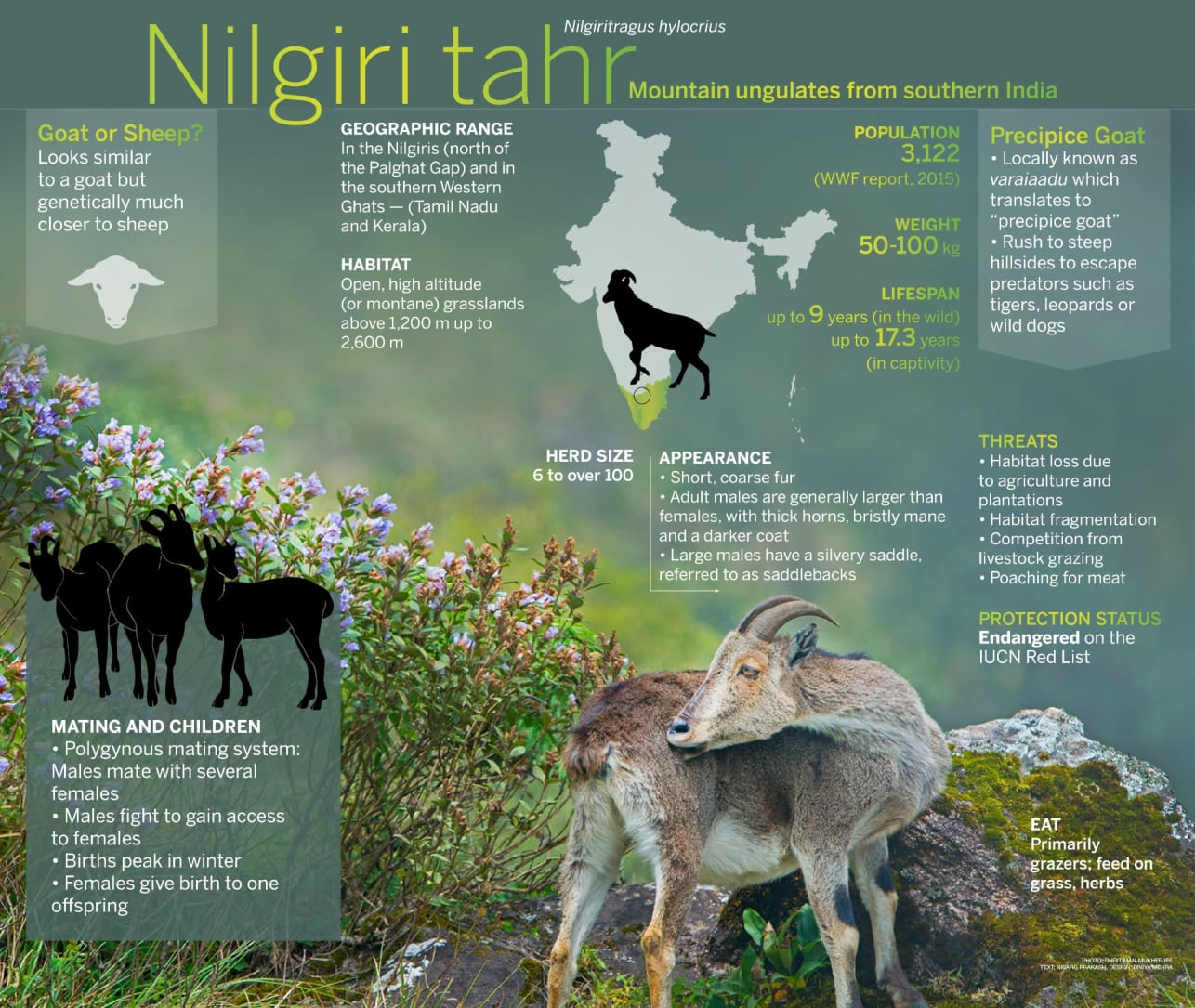Social Issues
Child Adoption in India
For Prelims: Adoption in India, Central Adoption Resource Authority, Hindu Adoption and Maintenance Act, 1956, Juvenile Justice (Care and Protection of Children) Amendment Act, 2021
For Mains: Laws Related to Adoption in India, Major Challenges Related to Adoption in India.
Why in News?
The Central Adoption Resource Authority (CARA) has been unable to bridge this gap between the number of children available for adoption and the number of prospective parents, resulting in prolonged delays in the adoption process.
- The waiting period for parents to receive an adoption referral has risen from 3 years in 2022 to approximately 3.5 years in 2025.
What is the Status of Child Adoption in India?
- State of Child Adoption in India: In 2024–25, 4,515 children were adopted, the highest since 2015.
- Of these, 4,155 were domestic adoptions, reflecting a growing acceptance of legal adoption in the country.
- Nodal Central Agency: The Central Adoption Resource Authority (CARA), established under the Juvenile Justice Act, 2015 is responsible for overseeing both domestic and international adoptions.
- State/UT Responsibility: The implementation of the Juvenile Justice Act, 2015 at the state and Union Territory level is carried out by various agencies, including:
- State Adoption Resource Agencies (SARA)
- Local Child Welfare Committees
- District Child Protection Units (DCPUs)
- Legal Framework:
- Hindu Adoption and Maintenance Act (HAMA), 1956: HAMA, 1956 permits legal adoption for individuals from the Hindu, Buddhist, Jain, and Sikh communities.
- Notably, adoptions under HAMA do not require registration with CARA.
- Juvenile Justice (Care and Protection of Children) Act, 2015: It governs adoptions for all citizens in India, regardless of religion.
- Under this Act, prospective adoptive parents are required to register on CARA’s portal, following which a Specialised Adoption Agency (SAA) conducts a Home Study Report (HSR).
- If found eligible, they are matched with a child who has been declared legally free for adoption.
- Hindu Adoption and Maintenance Act (HAMA), 1956: HAMA, 1956 permits legal adoption for individuals from the Hindu, Buddhist, Jain, and Sikh communities.
- International Framework: The Hague Convention on Protection of Children and Cooperation in Respect of Intercountry Adoption (1993) ensures that international adoptions are carried out in an ethical, legal, and transparent manner.
Central Adoption Resource Authority (CARA)
- About: CARA is a statutory & autonomous body under the Ministry of Women & Child Development.
- Objectives & Functions:
- It facilitates adoption of orphaned, abandoned, and surrendered children through its recognised adoption agencies.
- It monitors and regulates domestic adoptions under the Juvenile Justice (Care and Protection of Children) Act, 2015.
- It also serves as the Central Authority for inter-country adoptions under the Hague Convention on Intercountry Adoption, 1993, which India ratified in 2003.
What are the Key Challenges Hindering the Child Adoption Process in India?
- Widening Demand–Supply Gap: There is a significant gap between Prospective Adoptive Parents (PAPs) and adoptable children (13:1), with only a small fraction of children eligible for adoption due to issues like intact parental rights and lack of legal free status.
- Adoption delays have increased from 1 year in 2017 to 3.5 years in 2025, leading to concerns over illegal or informal adoptions, as highlighted by a Parliamentary Committee.
- Structural & Legal Hurdles: JJ Act, 2021 faces weak implementation, poor coordination among agencies, inadequate training, and legal hurdles like absentee guardians causing delays in adoption.
- The 2022 Standing Committee flagged inconsistencies between HAMA (simpler but lacks transparency) and the JJ Act (regulated but slower), raising concerns over trafficking and procedural delays.
- Mismatch in Age & Parental Preference: Around 34% of adoptable children are above 14 years, while most Indian parents prefer infants (0–2 years). This preference bias results in older and special needs children being overlooked.
- As per CARA data (2024), 60% of adopted children are female, and 80% belong to the 0–2 age group, reflecting a strong parental preference for younger children.
- High Rate of Child Returns: Between 2017–2019, there was a rise in adoptive parents returning children, 60% were girls, 24% had special needs, and many were over 6 years old.
- This reflects challenges in adjusting to adoptive homes due to inadequate counselling and preparation.
- LGBTQ+ Adoption & Legal Barriers: Due to traditional family norms and lack of legal recognition, LGBTQ+ individuals and couples face exclusion from formal adoption systems. This has led to a rise in informal or illegal adoptions within the queer community.
Eligibility Criteria for Prospective Adoptive Parents (Regulation 5 of Adoption Regulation, 2022)
Measures Taken to Improve Adoption and Foster Care in India
- Child Pool Expansion: CARA added children from Child Care Institutions (CCIs) to the legal adoption pool and classified them under 5 categories (Orphan, Abandoned, Surrendered, No Visitation, Unfit Guardianship) as per Supreme Court directions (SC, in 2023 while hearing a petition filed by a NGO)
- Digital Reforms: Upgraded CARINGS portal with Foster Care modules and new workflows for relative/step-parent adoptions, reducing processing time to 3–4 months.
- Mandatory Counselling (2025): CARA introduced structured counselling at pre-, during-, and post-adoption stages, with qualified counsellors to support adoptive families and children.
What Steps Can Be Taken to Strengthen and Streamline the Adoption System in India?
- Child-Centric Approach: Prioritize children’s right to family, care, and protection by shifting from parent-centric to child-centric adoption policies, aligned with the UNCRC.
- Simplify Adoption Procedures: Streamline JJ Act, 2021 and Adoption Regulations, 2022 with time-bound clearances, digital CCI–CARA integration, and dedicated adoption officers.
- Strengthen Psychosocial Support: Ensure proper implementation of CARA’s counselling mandate with trained professionals to minimise disruptions and support family bonding.
- Promote Awareness & Destigmatise Adoption: Launch IIEC (Information, Education, and Communication) campaigns to counter stigma around non-biological parenthood, and encourage adoption of older and special needs children.
|
Drishti Mains Question: Examine the social attitudes towards adoption in India. How can public awareness and institutional reforms together build a more adoption-friendly culture? |
Facts for UPSC Mains
Wind Energy Expansion and Biodiversity Conservation
Why in News?
India's rapid expansion of wind energy, reaching 51.3 GW by mid-2025, has raised concerns about its environmental impact, particularly on bird populations.
- A study by the Wildlife Institute of India (WII) highlighted high bird mortality at wind farms in the Thar Desert, home to critically endangered species.
- Additionally, as India expands offshore wind energy, concerns grow over impacts on marine biodiversity and inadequate environmental assessments.
What are the Concerns Regarding Wind Turbines' Impact on Avian Populations and Offshore Wind Energy?
Wind Turbines and Avian Populations
- High Bird Deaths Documented: The WII study in the Thar Desert found 124 bird carcasses near 90 wind turbines, estimating 4,464 bird deaths per 1,000 sq. km annually.
- Great Indian Bustard and Raptors (Birds of prey), are most affected due to their soaring flight and low reproduction rates, making them highly vulnerable to wind turbine collisions.
- The Thar Desert, part of the Central Asian Flyway, sees significant migratory bird traffic, adding to the vulnerability.
- Power Lines: The study also accounted for bird deaths from collisions with power lines connected to wind farms, compounding the issue, which were not factored into earlier studies.
- Lack of Environmental Oversight: Onshore wind farms are not required to conduct Environmental Impact Assessments (EIAs) in India, leading to projects being set up in ecologically sensitive zones without proper study.
Offshore Wind Energy Exploration
- Threat to Marine Biodiversity: Offshore wind farms can disturb marine habitats, especially sensitive breeding grounds for fish, turtles, and marine mammals.
- Installation activities like piling and dredging generate underwater noise, affecting echolocation and navigation of species like dolphins and whales.
- Maintenance of turbines and supporting vessels carries the risk of fuel and lubricant spills, potentially harming marine life.
- Offshore wind projects lack comprehensive studies on their impact on marine ecosystems. While offshore projects require EIAs, many reports are rapid and may overlook critical ecological factors.
- The rapid EIA for the Gulf of Khambhat offshore wind farm noted dolphins, sharks, and a reptile in the area, downplaying operational impacts.
- Technological and Logistical Challenges: India currently lacks domestic expertise and proven technology for deep-water installations. Harsh marine conditions can affect turbine durability and maintenance schedules.
How Can India Balance Wind Energy Development with Biodiversity Conservation??
- Site Selection: Use tools like Avian Sensitivity Tool for Energy Planning (AVISTEP) (an open-source tool by Birdlife International) to identify areas with minimal bird impact.
- AVISTEP categorizes India into avian sensitivity levels—‘low’, ‘moderate’, ‘high’, and ‘very high’ but ground-level studies are essential before installing wind farms.
- Zoning and Spatial Planning of Renewable Projects: Identify and map “no-go” zones for renewable energy infrastructure using long-term field data, satellite tracking, and conservation research.
- Establish designated power corridors to avoid fragmented infrastructure across GIB habitats.
- The Supreme Court-appointed Expert Committee has recommended demarcating priority, and potential conservation areas for targeted protection.
- Support Conservation Breeding and Species Revival: Implement the “jump-start” method by incubating late-stage eggs of GIB from Rajasthan and transferring the chicks to safe places to rebuild local populations.
- Technological Solutions: Painting one turbine blade to increase visibility and prevent bird strikes, along with implementing shutdown strategies during migration periods, are key mitigation measures.
- EIA Mandates: Require EIAs for all onshore wind farms to assess ecological risks.
- Integration of Wind, Solar, and BESS Systems: Combining Wind with Solar and Storage: India should focus on integrating wind energy with solar power and battery energy storage systems (BESS) to ensure round-the-clock power supply and grid stability.
- Monitoring & Research: Conduct surveys and long-term studies to track wind energy’s impact on wildlife, especially in sensitive areas like the Thar Desert.
Wind Power
- As of June 2025, Wind energy contributed 21.78% to India's total renewable energy generation.
- As per International Renewable Energy Agency (IRENA) Renewable Energy Statistics 2025, India ranks 4th globally in Wind Power.
- India's wind energy capacity has surged from approx. 21 GW in 2014 to 51.3 GW by June 2025, more than doubling in a decade.
- According to the National Institute of Wind Energy, India has a massive wind potential of 1164 GW at 150 meters above ground level, highlighting the vast untapped resources for further growth in the wind energy sector.
|
Drishti Mains Question: “India’s rapid wind energy expansion has come at an ecological cost.” Discuss. |
Facts for UPSC Mains
AI in Public Service Delivery
Why in News?
India’s first Artificial intelligence (AI) powered Anganwadi was launched in Waddhamna village, Nagpur district, Maharashtra.
- This pilot project is being hailed as a major leap in bridging the rural-urban digital divide in early childhood education, marking a significant advancement in public service delivery.
How can AI Aid in Public Service Delivery?
- Early Child Care: Maharashtra's AI-enabled Anganwadi integrates with the Poshan Tracker to monitor children's nutrition and health in real time.
- Anganwadi workers upload meal photos for instant dietary analysis, enabling predictive alerts on malnutrition risks.
- AI integration facilitates targeted delivery of supplementary nutrition under Integrated Child Development Scheme.
- Children now learn through virtual reality (VR) experiences, interactive stories, and drawing on smart boards.
- Smarter and Inclusive Governance: AI is helping the government move from a one-size-fits-all approach to tailored, real-time service delivery.
- BharatGen, a government-funded multimodal AI model, aims to enhance public service delivery in language, speech, and computer vision, catering to India's diverse population.
- At Mahakumbh 2025, AI tools were used to manage railway passenger flow, optimize crowd dispersal, and power multilingual chatbots, setting a global benchmark in tech-driven mass event management.
- Efficient and Targeted Welfare Delivery: AI models trained on high-quality anonymised datasets (via the IndiaAI Dataset Platform) can analyse patterns in poverty, health, education, etc.
- This helps policymakers identify gaps, predict needs, and deliver targeted benefits.
- Accessibility: Tools like Digital India BHASHINI, Sarvam-1 break language barriers, making services available in multiple Indian languages, and enhancing inclusivity for differently-abled individuals.
- Law Enforcement: AI enables predictive policing, real-time surveillance, and cyber threat detection.
- Delhi Police uses an AI-driven Facial Recognition System (FRS) to solve crimes and find missing persons.
- AI accelerates case research, aids in drafting judgments, and helps reduce backlogs, improving justice delivery and legal efficiency.
- For example, SUPACE (Supreme Court Portal for Assistance in Court's Efficiency) helps judges with legal research.
- Optimizing Agriculture and Ensuring Food Security: Project Farm Vibes, developed by Microsoft Research and the Agricultural Development Trust, Baramati, is transforming farming with data-driven insights.
- It uses AI tools to analyze field conditions, optimize irrigation, and provide real-time, localized farming recommendations.
- The project has led to a 40% increase in crop production, reduced water and fertilizer usage, and minimized post-harvest wastage.
- The AI in agriculture market is projected to grow from USD 1.7 billion in 2023 to USD 4.7 billion by 2028, boosting economic sustainability in farming.
- It uses AI tools to analyze field conditions, optimize irrigation, and provide real-time, localized farming recommendations.
- Tackling Climate Change and Environmental Monitoring: AI models support flood prediction, air quality tracking, and climate modelling.
- Platforms like Google DeepMind’s GenCast enable citizens to contribute localized weather data, improving real-time predictions.
- Mission Mausam, which aims to make India “Weather Ready” and “Climate Smart,” uses AI and satellite data from the Indian Meteorological Department and flood monitoring systems to improve disaster preparedness and flood forecasting.
- The Mausam App delivers weather updates and warnings in a user-friendly format.
- Education and Personalized Learning: AI-powered EdTech enables adaptive learning based on student needs. AI integration being explored in the government's Digital Infrastructure for Knowledge Sharing (DIKSHA) platform.
- In Tripura, IAS officer Chandni Chandran launched an AI-based initiative to tackle a 70% school dropout rate. Students’ career dreams were turned into AI-generated images and displayed on "Aspirational Boards" in classrooms.
- The move has boosted motivation and emotional engagement, with plans to expand it to more schools.
- In Tripura, IAS officer Chandni Chandran launched an AI-based initiative to tackle a 70% school dropout rate. Students’ career dreams were turned into AI-generated images and displayed on "Aspirational Boards" in classrooms.
- Strengthening Urban Governance and Smart Cities: AI improves traffic flow, waste management, and public service delivery.Bengaluru’s AI-driven Adaptive Traffic Control System (ATCS) cuts congestion at junctions.
- Improving Financial Governance and Taxation: AI helps detect fraud, prevent subsidy leakages, and automate auditing.
- MuleHunter.ai, developed by RBI, detects mule accounts used in financial scams.
- Better Healthcare: Centres of Excellence (CoEs) in AI for healthcare are developing solutions like disease prediction, which will holistically benefit the health of rural and urban populations across the country.
Conclusion
AI’s integration into India’s public service delivery enhances efficiency, inclusivity, and accessibility, improving governance. Through initiatives like the IndiaAI Mission, India is advancing towards a more transparent, citizen-centric system, positioning itself as a global leader in AI-powered governance.
|
Drishti Mains Question: How is Artificial Intelligence reshaping public service delivery in India? Illustrate with examples. |
UPSC Civil Services Examination, Previous Year Questions (PYQs)
Mains
Q. e-governance, as a critical tool of governance, has ushered in effectiveness, transparency and accountability in governments. What inadequacies hamper the enhancement of these features? (2023)
Q. E-Governance is not only about utilization of the power of new technology, but also much about critical importance of the ‘use value’ of information Explain. (2018)
Facts for UPSC Mains
Skill Impact Bonds
Why in News?
As India strives for economic growth and inclusive development, innovative models like the Skill Impact Bond (SIB) are emerging to address key challenges in skilling and employment, especially among marginalized communities and women.
- The Skill Impact Bond (SIB) 2025 report reveals that Jharkhand has the highest share of enrolled trainees, with women continuing to dominate enrolment in the apparel sector; however, gender-based pay disparities persist, despite improvements in female retention and placement rates.
What is the Skill Impact Bond (SIB)?
- About: SIB is India’s first Development Impact Bond (DIB), launched in 2021 focused on skills training and job placement.
- It shifts focus from enrollment to outcomes like placement and retention. It uses private-sector funding to address social and development challenges.
- Objective: To skill 50,000 youth, with 60% women, especially from marginalised and rural backgrounds, and ensure at least 30,150 retain jobs for 3+ months.
- Key Highlights of the SIB Report 2025:
- Top States: Jharkhand (27%), UP, Maharashtra, Odisha, and Telangana had highest enrollments.
- Popular Sectors:
- Women: Mainly trained in apparel, with rising numbers in retail, IT-enabled services (ITeS), and BFSI (banking, financial services, and insurance)
- Men: Moving from construction to sectors like automotive and telecom.
- Women-Led Skilling: Over 72% of 23,700+ trainees were women from vulnerable backgrounds. Female certification rate reached 92%, and job placement was 81%. Self-employment among women rose from 6% to 14%.
- Better Job Outcomes: 75% of all trainees got jobs, and 60% stayed employed for over 3 months—above national average. Female employment increased from 35% to 48%.
- Gender Pay Gap: Men earned more (Rs 12,400–15,700) than women (Rs 11,500–13,000) despite similar job outcomes.
What is the Status of Skill Development in India?
- Low Employability: As per India Skills Report 2024, only 51.25% of assessed young people in India possessed the necessary skills to be employable.
- Low Formal Training: As per the Economic Survey 2023–24, only 4.4% of youth are formally skilled, and 16.6% are informally trained.
- Skill Gaps in Industry: According to ManpowerGroup's (US-based MNC) 2025 Global Talent Shortage Survey, 75% of global employers are struggling to find skilled workers.
- India has a 60%-73% demand-supply gap in key roles such as ML engineer, data scientist, DevOps engineer, and data architect.
- Underemployment: As per Economic Survey 2024–25, over 50% of graduates and 44% of postgraduates are in low-skill jobs, indicating inefficient workforce utilisation.
- Limited Women Participation: In India, women constitute 40% of STEM students but only 14-27% of STEM professionals, according to the Ministry of Science and Technology.
What are the Key Challenges Hindering Skill Development in India?
- Inconsistent Quality & Infrastructure Gaps: Many ITIs, especially in rural areas, lack trained instructors and modern equipment, leading to low training quality and employability.
- Industry Disconnect & Skill Mismatch: Skilling schemes like PMKVY & Skill India focus on syllabus completion over practical relevance.
- Key sectors like AI, cybersecurity, and green energy are often underserved.
- Low Private Sector Role & Rural Exclusion: Limited private sector participation due to red tape, low incentives, and weak academia-industry links.
- Despite Skill India Digital Hub (SIDH), skilling remains urban-focused, sidelining the 90% informal workforce. Just 10% of rural workers receive formal skill training (WEF).
Key Skill Development Schemes and Initiatives
- Skill India Mission
- Pradhan Mantri Kaushal Vikas Yojana (PMKVY)
- Pradhan Mantri National Apprenticeship Promotion Scheme (PM-NAPS)
- India Skills Accelerator (ISA)
- Pradhan Mantri Kaushal Kendras (PMKK)
- PM Vishwakarma Yojana
- SANKALP (Skills Acquisition and Knowledge Awareness for Livelihood Promotion)
- STRIVE (Skill Strengthening for Industrial Value Enhancement)
- Deen Dayal Upadhyaya Grameen Kaushalya Yojana (DDU-GKY)
- Recognition of Prior Learning (RPL)
What Measures Should be Taken to Reform India’s Skilling Ecosystem?
- Inclusive Rural Skilling: Launch a Rural Skilling and Livelihood Mission focused on agri-tech, food processing, and crafts. Use mobile centers, village hubs, and digital literacy programs.
- Future-Ready & Digital Skilling: Align curriculum with Industry 4.0, green jobs, and digital economy.
- Sector Skill Councils (SSCs) to co-design courses with MSMEs and gig platforms.
- Expand Skill India Digital Hub with AI-based multilingual content and 5G-enabled hubs in Tier-2/3 cities.
- Education Integration & Women’s Skilling: Introduce vocational training from school level under NEP 2020 and link with National Credit Framework.
- Promote women’s skilling in STEM, finance, and gig roles through flexible training, digital access, childcare, grants, and mentorship.
- Monitoring, Soft Skills & Accountability: Use AI-driven dashboards, outcome-based funding, geo-tagging, biometric attendance, and third-party audits to ensure accountability.
|
Drishti Mains Question: Discuss the significance of the Skill Impact Bond (SIB) initiative in reimagining India’s skilling ecosystem. How does it promote gender empowerment and innovation in outcome-based financing? |
UPSC Civil Services Examination Previous Year Question (PYQ)
Prelims
Q. With reference to Pradhan Mantri Kaushal Vikas Yojana, consider the following statements: (2018)
- It is the flagship scheme of the Ministry of Labour and Employment.
- It, among other things, will also impart training in soft skills, entrepreneurship, and financial and digital literacy.
- It aims to align the competencies of the unregulated workforce of the country to the National Skill Qualification Framework.
Which of the statements given above is/are correct?
(a) 1 and 3 only
(b) 2 only
(c) 2 and 3 only
(d) 1, 2 and 3
Ans: (c)
Mains
Q. “Demographic Dividend in India will remain only theoretical unless our manpower becomes more educated, aware, skilled and creative.” What measures have been taken by the government to enhance the capacity of our population to be more productive and employable? (2016)
Q: “Earn while you learn" scheme needs to be strengthened to make vocational education and skill training meaningful.” Comment (2021)
Important Facts For Prelims
NBWL Approval to Sharavathi Hydroelectric Project
Sharavathi Pumped Storage Hydroelectric Project in Karnataka has got in-principle approval from the National Board for Wildlife (NBWL), despite ecological concerns over its impact on the Sharavathi Valley Lion-tailed Macaque Sanctuary in the Western Ghats.
- The project will now seek approval under the Forest Conservation Act, 1980, before returning for final NBWL approval.
Sharavathi Valley Wildlife Sanctuary
- It is located in the Sharavathi River Valley in Shivamogga District of Karnataka, spans 431.23 sq. km in the Western Ghats.
- Rich in flora and fauna, it houses flora species like Dhoopa, Gulmavu, and Nandi etc.
- Wildlife includes bison, spotted deer, tigers, panthers, and lion-tailed macaques.
- Attractions include Jog Falls, Linganamakki Reservoir, and diverse animal and bird species.
Sharavathi Pumped Storage Hydroelectric Project
- It is a proposed 2,000 MW project in Sharavathi Valley Lion-tailed Macaque Sanctuary, using pumped storage between Gerusoppa (lower) & Talakalale Dams (upper) via underground turbines for grid stability and renewable energy.
What is the National Board for Wildlife (NBWL)?
- About: NBWL is a statutory body constituted in 2003 under Section 5A of Wild Life (Protection) Act, 1972, replacing the Indian Board for Wildlife (1952) as an apex advisory body on wildlife conservation and forest development.
- Composition: The NBWL is a 47-member statutory board, chaired by the Prime Minister, with the Minister of Environment, Forest and Climate Change as the Vice Chairperson.
- Members include officials like the Chief of Army Staff, Defence Secretary, Expenditure Secretary, and 10 eminent conservationists nominated by the Central Government. The Additional Director General of Forests (Wildlife) serves as the Member-Secretary.
- Key Functions: It is an advisory body to the Central Government, responsible for guiding wildlife conservation policies, reviewing matters related to wildlife protection.
- It approves projects in and around protected areas (PAs) and eco-sensitive zones (within 10 km).
- Standing Committee: The Standing Committee is a smaller body under NBWL with up to 10 members, chaired by the Minister of Environment, Forest and Climate Change.
- It serves as a project clearance body, responsible for evaluating and approving proposals in protected areas and eco-sensitive zones, while the full NBWL focuses on broader policy decisions.
What are the Key Facts Related to Lion-Tailed Macaques?
- About: The Lion-tailed Macaque (Macaca silenus) is an old-world monkey species endemic to the Western Ghats of India.
- Also called the “wanderoo” or “beard ape”, it is known for its distinctive light-coloured mane surrounding its black face and chin.
- Key Features:
- Size: Among the smallest macaques; weighs 2–10 kg, body length 42–61 cm, tail length ~25 cm with a black tuft (larger in males).
- Appearance: Black fur with light-grey/silver mane around head and chin.
- Social Behaviour: Lives in hierarchical groups (10–20); shy and territorial. Dominant males produce loud ‘whoop’ calls to warn intruders.
- Activity Zone: Arboreal, spending time in the upper canopy of tropical moist evergreen forests.
- Habitat & Distribution:
- Endemic to Western Ghats, found in Karnataka, Kerala, Tamil Nadu; prefers undisturbed, continuous evergreen forest; highly sensitive to fragmentation.
- Found in regions like Anamalai Hills, Nelliyampathy, Nilambur Ghats, Sholayar, Gavi, Sabarimala, Vallimalai Hills, Agumbe, and Valparai plateau (Anamalai Tiger Reserve).
- Endemic to Western Ghats, found in Karnataka, Kerala, Tamil Nadu; prefers undisturbed, continuous evergreen forest; highly sensitive to fragmentation.
- Diet & Ecological Role: Primarily frugivorous, eats fruits, seeds, leaves, buds, insects, small vertebrates. It plays a key role in seed dispersal and forest ecosystem health.
- Threats: Over 99% habitat loss due to deforestation, agriculture, urbanisation which led to fragmentation, restricted movement and genetic flow.
- Human-wildlife conflict is increasing due to habitat degradation and food scarcity, causing behavioural changes.
- As per Kerala Forest Research Institute (KFRI) and University of Mysore (2024) report, only around 4,200 remain, just 25% of the original population.
- Conservation Status:
- IUCN Red List: Endangered
- CITES: Appendix I
- Wildlife (Protection) Act, 1972: Schedule I
Note: Strategic Habitat Use amid Human Pressure
- A study by the Centre for Wildlife Studies (CWS) in Silent Valley National Park, Kerala found that lion-tailed macaques adapt their behavior based on human presence.
- A troop in the buffer zone (more disturbed) used a smaller range and stayed mostly in the mid-canopy (94.2%), avoiding the ground.
- In contrast, a troop in the core zone (less disturbed) used a larger area and also used the forest floor, showing the species' ecological flexibility.
UPSC Civil Services Examination, Previous Year Questions (PYQs)
Prelims
Q. Which one of the following groups of animals belongs to the category of endangered species? (2012)
(a) Great Indian Bustard, Musk Deer, Red Panda and Asiatic Wild Ass
(b) Kashmir Stag, Cheetal, Blue Bull and Great Indian Bustard
(c) Snow Leopard, Swamp Deer, Rhesus Monkey and Saras (Crane)
(d) Lion-tailed Macaque, Blue Bull, Hanuman Langur and Cheetal
Ans: (a)
Q. If a particular plant species is placed under Schedule VI of the Wildlife Protection Act, 1972, what is the implication? (2020)
(a) A licence is required to cultivate that plant.
(b) Such a plant cannot be cultivated under any circumstances.
(c) It is a Genetically Modified crop plant.
(d) Such a plant is invasive and harmful to the ecosystem.
Ans: (a)
Rapid Fire
Nilgiri Tahr
A joint census across Kerala and Tamil Nadu recorded 2,668 Nilgiri Tahrs, with 1,365 in Kerala and 1,303 in Tamil Nadu.
Nilgiri Tahr (Nilgiritragus hylocrius)
- About: Also known as Varayaadu or Nilgiri Ibex, it is a caprine ungulate endemic to the Western Ghats , specifically in Tamil Nadu (where it is the state animal) and Kerala.
- It inhabits montane grasslands and shola forests at 1,200–2,600 m elevation, thriving on grassy slopes and rocky cliffs of the Western Ghats.
- The Eravikulam National Park (ENP) in Kerala hosts the largest population with smaller populations in the Palani Hills, Srivilliputtur, Meghamalai, and Agasthiyar Ranges.
- Behaviour & Life Cycle: A diurnal species, with average lifespan of around 3-3.5 years, although the species can live up to 9 years in ideal conditions.
- Threats: Habitat loss (deforestation, hydroelectric projects, monoculture), livestock competition, poaching, and local extinction (e.g., Karnataka highlands).
- Ecological Significance: Key prey for tiger and leopard, coexists with endemic species like the Nilgiri langur and lion-tailed macaque; an indicator of montane grassland health.
- Conservation Status:
- IUCN Status: Endangered
- WPA, 1972: Schedule-I
| Read More: Nilgiri Tahr |
Rapid Fire
Agnishodh and Project SAMBHAV
Chief of the Army Staff (COAS), General Upendra Dwivedi, inaugurated 'Agnishodh', the Indian Army Research Cell (IARC), at the IIT Madras campus. The COAS also highlighted Project SAMBHAV (Secure Army Mobile Bharat Vision) as a key tech initiative for secure communication.
Agnishodh
- Agnishodh serves as a bridge between academic research and military needs, converting lab-scale innovations into field-ready defence technologies.
- It is aligned with Indian Army Five Pillars of Transformation encompassing technology absorption, structural changes, human resource development and increasing cohesion between the three services.
- Agnishodh focuses on areas like Artificial Intelligence, Quantum computing, cybersecurity, wireless communication, and unmanned systems.
- It also aims to upskill military personnel in these emerging domains, building a tech-savvy defence workforce.
- Agnishodh reflects the Army’s focus on modern and psychological warfare, and its push for self-reliance through national technology missions like INDIAai and Chip-to-Startup.
Project SAMBHAV
- Launched under the Indian Army's 2024 Year of Technology Absorption, SAMBHAV is a secure, 5G-based, network-agnostic mobile system.
- It enables instant and encrypted communication on the move, even in remote or high-risk operational areas.
- SAMBHAV is designed to boost battlefield communication, making it faster, more secure, and reliable.
| Read more: Strategic Defence Technologies in India |
Rapid Fire
Mera Gaon Meri Dharohar (MGMD)
Under the Mera Gaon Meri Dharohar (MGMD) initiative, data for around 4.7 lakh villages have been uploaded on the MGMD portal.
Mera Gaon Meri Dharohar (MGMD)
- About: It is a flagship initiative launched in 2023 under the National Mission on Cultural Mapping (NMCM), implemented by the Ministry of Culture (MoC) in collaboration with the Indira Gandhi National Centre for the Arts (IGNCA).
- Objective: It aims to document and digitally map the cultural identity of approximately 6.5 lakh villages across India.
- This data is made accessible to virtual and physical visitors through the MGMD web portal, which acts as the National Cultural Workplace.
- Village Categorisation: Villages are classified into 7 themes- Arts and Crafts, Ecologically Oriented , Scholastic (textual/scriptural) and Epic (Ramayana, Mahabharata, Puranas), etc.
National Mission on Cultural Mapping (NMCM):
- Implemented by IGNCA, NMCM aims to identify and digitally map India’s cultural assets to revitalise rural economies and promote self-reliance.
- It focuses on creating artist directories, digital inventories of art forms and tradition bearers, and policies for preservation and welfare of practitioners.
| Read More: Mera Gaon, Meri Dharohar Programme |


